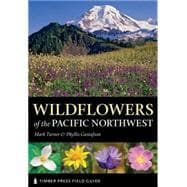
Note: Supplemental materials are not guaranteed with Rental or Used book purchases.
Purchase Benefits
What is included with this book?
Mark Turner is a professional photographer who has been photographing gardens and native plant environments in the Pacific Northwest for over 25 years. He brings a strong sense of photographic design, attention to detail, and curiosity about both native and garden plants to his work.
| Preface | p. 9 |
| Acknowledgments | p. 10 |
| How to Use This Book | p. 13 |
| Climate, Geography, and Plant Habitats | p. 19 |
| Exploring for Wildflowers | p. 45 |
| Plant Families | p. 50 |
| White or Whitish Flowers | p. 57 |
| 3 or 6 petals | p. 58 |
| 4 petals | p. 80 |
| 5 irregular petals | p. 92 |
| 5 symmetrical petals (ovary superior) | p. 99 |
| 5 symmetrical petals (ovary inferior) | p. 120 |
| 5 irregular petals forming a tube | p. 145 |
| 5 symmetrical petals forming a tube | p. 148 |
| 5 petals joined into a bell | p. 164 |
| Composite flowers | p. 167 |
| Many petals | p. 183 |
| No obvious petals | p. 183 |
| Yellow Flowers | p. 185 |
| 3 or 6 petals | p. 186 |
| 4 petals | p. 193 |
| 5 irregular petals | p. 205 |
| 5 symmetrical petals (ovary superior) | p. 213 |
| 5 symmetrical petals (ovary inferior) | p. 223 |
| 5 irregular petals forming a tube | p. 237 |
| 5 symmetrical petals forming a tube | p. 248 |
| 5 petals joined into a bell | p. 250 |
| Composite flowers | p. 251 |
| Many petals | p. 295 |
| No obvious petals | p. 296 |
| Orange Flowers | p. 297 |
| 3 or 6 petals | p. 298 |
| 5 symmetrical petals (ovary superior) | p. 299 |
| 5 irregular petals forming a tube | p. 300 |
| 5 symmetrical petals forming a tube | p. 300 |
| 5 petals joined into a bell | p. 301 |
| Composite flowers | p. 302 |
| No obvious petals | p. 303 |
| Pink to Red or Red-Purple Flowers | p. 305 |
| 3 or 6 petals | p. 306 |
| 4 petals | p. 320 |
| 5 irregular petals | p. 330 |
| 5 symmetrical petals (ovary superior) | p. 337 |
| 5 symmetrical petals (ovary inferior) | p. 356 |
| 5 irregular petals forming a tube | p. 362 |
| 5 symmetrical petals forming a tube | p. 377 |
| 5 petals joined into a bell | p. 386 |
| Composite flowers | p. 391 |
| Many petals | p. 397 |
| No obvious petals | p. 397 |
| Violet to Blue or Blue-Purple Flowers | p. 399 |
| 3 or 6 petals | p. 400 |
| 4 petals | p. 405 |
| 5 irregular petals | p. 407 |
| 5 symmetrical petals (ovary superior) | p. 418 |
| 5 irregular petals forming a tube | p. 423 |
| 5 symmetrical petals forming a tube | p. 438 |
| 5 petals joined into a bell | p. 447 |
| Composite flowers | p. 449 |
| Brown and Green Flowers | p. 457 |
| 3 or 6 petals | p. 458 |
| 4 petals | p. 464 |
| 5 irregular petals | p. 466 |
| 5 symmetrical petals (ovary superior) | p. 467 |
| 5 symmetrical petals (ovary inferior) | p. 467 |
| 5 irregular petals forming a tube | p. 469 |
| Composite flowers | p. 469 |
| No obvious petals | p. 470 |
| About the Photographs | p. 474 |
| Additional Photography | p. 475 |
| Bibliography | p. 476 |
| Glossary | p. 480 |
| Index | p. 483 |
| Table of Contents provided by Ingram. All Rights Reserved. |
The New copy of this book will include any supplemental materials advertised. Please check the title of the book to determine if it should include any access cards, study guides, lab manuals, CDs, etc.
The Used, Rental and eBook copies of this book are not guaranteed to include any supplemental materials. Typically, only the book itself is included. This is true even if the title states it includes any access cards, study guides, lab manuals, CDs, etc.